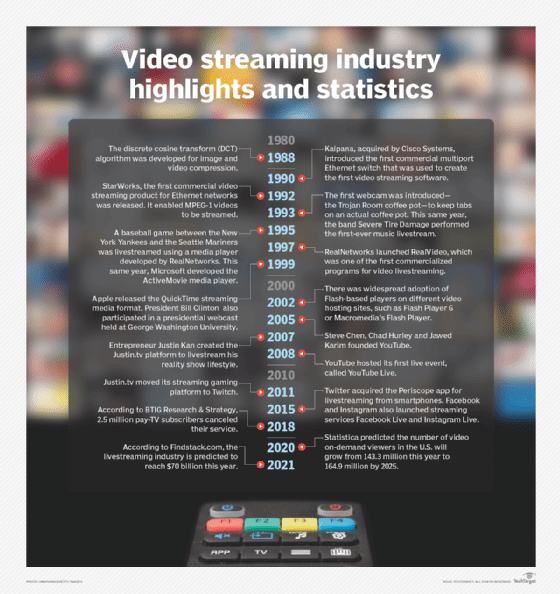video streaming service
What is a video streaming service?
A video streaming service is an on-demand online entertainment source for TV shows, movies and other streaming media.
Video streaming services typically focus on studio-produced content, such as movies and TV. Services that focus on content created by end users, such as YouTube and Twitch, are generally classified as social media or streaming platforms.
These services provide an alternative to cable and satellite on-demand services, often at a lower cost. Use of streaming services often requires fees, either per view or a subscription. Other services are ad-supported or run on a freemium model. The availability, content and price of services can vary from one region to another.
Video streaming services have different content from each other. Some focus on content from a single brand, network or genre, while other services are more general. For example, some services focus on offering TV made in Asian countries. Some streaming services create their own original content.
Video streaming services can be accessed through a web browser or an app. Some services feature hardware support for numerous devices such as smart TVs, streaming media receivers, computers, tablets and smartphones. Most services are available on any platform to reach as many potential customers as possible. For example, subscribers can watch Apple TV+ on an Android phone through a web browser.
Streaming devices include the following:
- Amazon Fire Stick.
- Apple TV.
- Google Chromecast.
- Roku.
To capture a wider audience, many free over-the-air TV channels also have an internet livestream available. These often show exactly what is on the television. These can be region-locked to prevent them from being viewed from another country or area.
A practice that video streaming service companies are cracking down on is password sharing. This is when one person pays for a service subscription, but it is used by several people who are not in the same household. Password sharing is usually against the service's terms of service. To reduce the prevalence of this practice and convert some of these people into paying subscribers, some services have started to block devices when password sharing is detected. Service companies often use indicators such as the user's IP address or device IDs to find password sharing.
Popular paid video streaming services today include the following:
- Amazon Prime Video.
- Apple TV+.
- Crunchyroll.
- Disney+.
- Max, formerly called HBO Max.
- Hulu.
- Netflix.
- Peacock.
- YouTube Premium.
Popular free video streaming services today include the following:
- Crackle.
- Tubi.
- Roku Channel.
- Pluto TV.
Microsoft Stream is a Microsoft 365-based service that enables an organization to host and share internal video streams. These can be protected and subject to data retention, unlike videos hosted on most public video-sharing platforms.

Illegal video streaming services
Several websites host and make available movies and TV that they are not licensed to broadcast, and they do not pay royalties to the content owners. These sites also often host malware, viruses or unsafe ads. Their use is not recommended.
How do video streaming services work?
Depending on the size of their viewership, video streaming services host content on their own servers or on cloud servers. For smaller services, it might be beneficial to use cloud servers as these can be readily scaled to meet demand and have servers in various geographic regions. Larger services usually own their own servers as the economies of scale make it more cost-efficient.
Many services use a content delivery network (CDN). The CDN reduces the load on their servers and puts the content geographically closer to the end user.
Video streaming services use a lot of bandwidth. Reportedly, Netflix alone represents 15% of the internet's total global bandwidth use. To reduce the cost of sending all this data, these services often have servers colocated with internet service providers (ISPs) and have peering network agreements. Some ISPs have begun to balk at this high usage and are demanding payment from the services themselves, raising concerns about net neutrality. This usage has increased as more people switch to video streaming services instead of traditional television providers.
Learn the differences between video streaming vs. video conferencing and see why live enterprise video streaming use is expanding.
